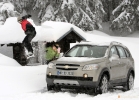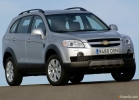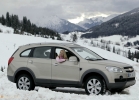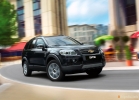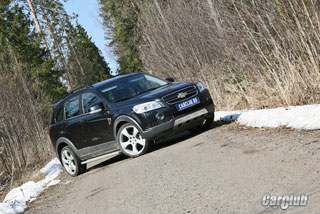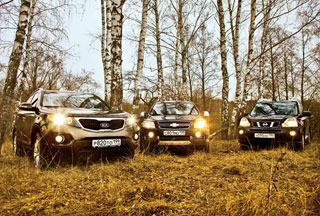CHEVROLET CAPTIVA test drive since 2006 SUV
Polyglot
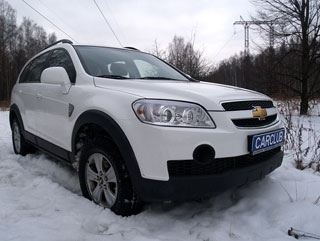 The class of parquet SUVs originated more than 10 years ago and since then is the most dynamic segment of the automotive market. Demand for SUVs is stable in all the largest world markets, whether it is cramped Japan or spacious America. Even in economical Europe, in recent years, many customers prefer more practical alternate to family universals. Therefore, in the pleasure of selling all -wheel drivers, only the most lazy or those who are late for an off -road train and are now trying to jump on the bandwagon to grab their piece from the tidbit of the tidbit.
The class of parquet SUVs originated more than 10 years ago and since then is the most dynamic segment of the automotive market. Demand for SUVs is stable in all the largest world markets, whether it is cramped Japan or spacious America. Even in economical Europe, in recent years, many customers prefer more practical alternate to family universals. Therefore, in the pleasure of selling all -wheel drivers, only the most lazy or those who are late for an off -road train and are now trying to jump on the bandwagon to grab their piece from the tidbit of the tidbit. For the European Opel and Korean GM-DAT, the construction of a parquet SUV is a bold experiment in many directions. How Asian and European engineers are coordinated, which technologies, more affordable Korean or advanced German, etc. There are many questions, and the answer is still only one SUV CHEVROLET CAPTIVA, which recently appeared in the salons of official dealers.
In fact, this is the first experience of building parquet SUVs for Europe and Asia as part of the General Motors concern. At the same time, the technologies of American Hammers and Escalaids, alas, are unprofitable for creating
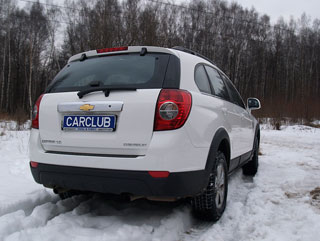 parkatnikov. Opel used to produce SUVs under the license of the Japanese ISUZU, and Daewoo, later transformed in the GM-DAT, for some time owned the Korean brand of Ssangyong, which collaborated with the Daimlerchrysler concern in the construction of all-wheel drives. However, the SUVs are a very young class of cars, and the standards in it change so quickly that the experience of 5-10 years ago is no longer suitable for use in the construction of a machine that would be well sold for at least 5-7 years.
parkatnikov. Opel used to produce SUVs under the license of the Japanese ISUZU, and Daewoo, later transformed in the GM-DAT, for some time owned the Korean brand of Ssangyong, which collaborated with the Daimlerchrysler concern in the construction of all-wheel drives. However, the SUVs are a very young class of cars, and the standards in it change so quickly that the experience of 5-10 years ago is no longer suitable for use in the construction of a machine that would be well sold for at least 5-7 years. Therefore, having combined efforts, Europeans with the Koreans took into account all the world experience in the construction of SUVs and issued the twins of the Chevrolet Captiva and Opel Antara. While the second is just preparing for Russian debut, but the production of the captive has already begun and not somewhere, but in St. Petersburg. Here, at the capacities of the Arsenal factory, commodity machines are assembled from Korean machine tools using screwdriver technology. This scheme allows you to significantly save on duties and, accordingly, provides a price advantage over competitors. It remains to find out whether this polyglot of Korean-German-Russian origin has any more positive qualities, except for a tempting price.
For a test drive, we chose the basic version of Captiva with a 2.4-liter engine with a capacity of only 133 hp. and
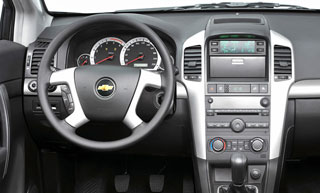 mechanical transmission. The highlight of our car is a 7-seater salon. If girls like Toyota RAV4, then Captiva, which is comparable with Hyundai Santafe and Mitsubishi Outlander XL, is already absolutely male car, regardless of the power of the motor and the type of gearbox, like Toyota RAV4. This is confirmed not so much by dimensions as by appearance. A healthy golden cross, powerful wheel arches with black pads, especially noticeable on the white body, and long overhangs with the head give out the utilitarianism of the machine: for the girl this is the same as putting on rubber boots and a raincoat. Yes, and parking on such a car is not very convenient. Review of the back through the salon mirror leaves much to be desired behind small glass and powerful body racks when parking backwards, you can easily not see a low car or child. This forces to navigate mainly on the side mirrors, almost like a truck. But in these healthy burdocks, almost everything that happens on the sides of the car is visible.
mechanical transmission. The highlight of our car is a 7-seater salon. If girls like Toyota RAV4, then Captiva, which is comparable with Hyundai Santafe and Mitsubishi Outlander XL, is already absolutely male car, regardless of the power of the motor and the type of gearbox, like Toyota RAV4. This is confirmed not so much by dimensions as by appearance. A healthy golden cross, powerful wheel arches with black pads, especially noticeable on the white body, and long overhangs with the head give out the utilitarianism of the machine: for the girl this is the same as putting on rubber boots and a raincoat. Yes, and parking on such a car is not very convenient. Review of the back through the salon mirror leaves much to be desired behind small glass and powerful body racks when parking backwards, you can easily not see a low car or child. This forces to navigate mainly on the side mirrors, almost like a truck. But in these healthy burdocks, almost everything that happens on the sides of the car is visible. The driver's place only confirms the impression of the patriarchal of the machine. Solid efforts on all pedals, large moves of the gearbox, a large bagel - the girl, of course, can handle all this, but she will feel uncomfortable here. Yes, and the interior decoration is not very friendly box in the center of the front
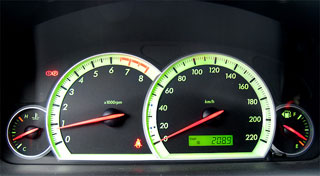 panels, it is not clear why covered with a visor. In more expensive versions, a color monitor is installed here, but in its absence, the cord box looks very depressing. It would be better if there was an open niche for the phone. The glove box is slightly larger than on other Chevrolet models, but it is still hinged and is not cooled by air from the air conditioner, which is necessary when traveling out of town, which, in fact, is calculated and calculated. In an attempt to add a highlight, the developers for some reason came up with a handbrake of a non-traditional shape: with a button located on top, and not from the end, like on all normal machines. Of course, you can get used to it, but such a scheme does not add any amenities, so its purpose is not clear.
panels, it is not clear why covered with a visor. In more expensive versions, a color monitor is installed here, but in its absence, the cord box looks very depressing. It would be better if there was an open niche for the phone. The glove box is slightly larger than on other Chevrolet models, but it is still hinged and is not cooled by air from the air conditioner, which is necessary when traveling out of town, which, in fact, is calculated and calculated. In an attempt to add a highlight, the developers for some reason came up with a handbrake of a non-traditional shape: with a button located on top, and not from the end, like on all normal machines. Of course, you can get used to it, but such a scheme does not add any amenities, so its purpose is not clear. It is better to place a wife and children from behind. There is a large supply of space along the length, absolutely even floor, the back of the seat is divided into two parts and adjusted along the angle of inclination, and between the front seats, a 2-seater cup holder and a box for trifles are provided. But the width of the body is not very large three adults rest against each other
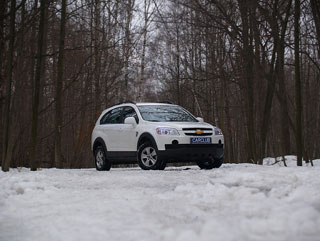 shoulders. By the way, for children there is also a third row of seats that laid out in the trunk. Adults here are not waiting for their knees at the chest level, so it is simply impossible to go so far. But schoolchildren will be convenient for their own corner in a large father's car. Yes, and parents should like such a placement physically unable to reach the door and accidentally open them.
shoulders. By the way, for children there is also a third row of seats that laid out in the trunk. Adults here are not waiting for their knees at the chest level, so it is simply impossible to go so far. But schoolchildren will be convenient for their own corner in a large father's car. Yes, and parents should like such a placement physically unable to reach the door and accidentally open them. On the road, Captiva behaves, as is appropriate to a large SUV, - imposingly and slowly. The high body does not react at all to the rut, but the lateral wind is afraid. Passing turns quickly? What for? If you need to go around the sudden obstacle of Captiva will cope. The modern design with independent pendants and a bearing body ennobles the habits of the SUV, but I don’t want to swing at all without need to be dashing, and it doesn’t really matter. Despite the quite decent volume of 2.4 liters and a 16-valve head of the block, the motor gives only 133 hp, which are clearly not enough for active driving. Even a gentle moment characteristic, which reaches its peak at 220 Nm at 2000 rpm, does not save the situation. Tarts from the place of Captiva, large wheels and a difficult transmission affects without much agility. In order to keep up with the flow, the motor has to be pretty promoted, the benefit of the limiter is only at 6500 rpm, although the engine gives out the maximum power at 5000 rpm. But when switching, it is better not to rush a long -term mechanism may not work with a lever that is too fast.
 When leaving on the highway, morally I was already ready for the fact that today I was assigned the role of a heavenly slow -gun, but Captiva presented a pleasant surprise, perhaps the first from the moment of our acquaintance. In the last fifth gear, the SUV easily drove the speedometer arrow for a mark of 140 km/h, then let the number 160 and even 175 km/h (according to the speedometer) was slowly reached. And this despite the fact that the declared maximum speed of the SUV is 183 km/h. It seems that Captiva can easily reach its maximum speed, but the free area, alas, has ended and the time has come to test the brakes. Although they are disk on all wheels and formally besiege the car quickly enough, the sensations behind the wheel are not pleasant. The car pecks strongly with his nose, lifts the stern and is pretty scouring, especially if you have to decline in the rut. I wonder how a more powerful version with a 3.2 -liter engine with a capacity of 211 hp will behave? After all, its maximum speed exceeds 200 km/h, while the brakes are exactly the same
When leaving on the highway, morally I was already ready for the fact that today I was assigned the role of a heavenly slow -gun, but Captiva presented a pleasant surprise, perhaps the first from the moment of our acquaintance. In the last fifth gear, the SUV easily drove the speedometer arrow for a mark of 140 km/h, then let the number 160 and even 175 km/h (according to the speedometer) was slowly reached. And this despite the fact that the declared maximum speed of the SUV is 183 km/h. It seems that Captiva can easily reach its maximum speed, but the free area, alas, has ended and the time has come to test the brakes. Although they are disk on all wheels and formally besiege the car quickly enough, the sensations behind the wheel are not pleasant. The car pecks strongly with his nose, lifts the stern and is pretty scouring, especially if you have to decline in the rut. I wonder how a more powerful version with a 3.2 -liter engine with a capacity of 211 hp will behave? After all, its maximum speed exceeds 200 km/h, while the brakes are exactly the same If you avoid extreme situations, then Captiva to the best of comfort to break through a long -flowing, energy -intensive suspension on the asphalt is quite difficult, but soft shock absorbers allow significant rolls in corners, and sometimes the build -up, which is especially unpleasant in stressed turns.
Outside of roads with solid coating, Captiva has proven a significant clearance and toothy Cooper tires allowed to climb far enough. However, any obstacles, be it
 filted snow or smoky soil, you have to overcome only on the move without sparing the suspension and passengers. The tight adhesion and the absence of the function of forced blocking of an electronically controlled hydraulic coupling connecting the rear wheels does not allow moving into the tightness. Even with a calm ride, the salon now and then was filled with the smell of Gary either slipping the clutch, or there is not enough degree of blocking the coupling, as a result of which it turns. Although, to the honor of Captiva, we didn’t have to run behind the tractor, and we didn’t stop anywhere, although the car is clearly not designed for permanent operation outside the roads.
filted snow or smoky soil, you have to overcome only on the move without sparing the suspension and passengers. The tight adhesion and the absence of the function of forced blocking of an electronically controlled hydraulic coupling connecting the rear wheels does not allow moving into the tightness. Even with a calm ride, the salon now and then was filled with the smell of Gary either slipping the clutch, or there is not enough degree of blocking the coupling, as a result of which it turns. Although, to the honor of Captiva, we didn’t have to run behind the tractor, and we didn’t stop anywhere, although the car is clearly not designed for permanent operation outside the roads. As a result, an attempt to harness the horse and trembling doe into one cart, and for the minimum price, as expected, it turned out, if not a failure, then a means of movement. To be called a car, it would be desirable to add integrity, but neither fish nor meat. Even the name Captiva is artificially synthesized and does not express anything just four wheels with a motor and a large body even.
For assault on a serious off -road captive, a more advanced transmission with differential locks is not enough, and the reducing gear would not hurt. On the Chevrolet highway, only calm, undemanding drivers who will cross Captiva from a small frame SUV, for example, Kia Sportage of the first generation or the previous Suzuki Grand Vitara, can be attached. Captiva will appeal to those who cross her from another Chevrolet Niva.
I admit that captiva can be selected by calculation: a large 7-seater SUV for 30 thousand dollars is an excellent offer, all the closest competitors are more than a third. But such unions, although they are long and strong, rarely carry real happiness, at least drivers ...
Text and photo: Leonid Pavlov
+
Spacious salon
Price
-
Weak engine
Simple interior decoration
Weak off -road potential
The price of the tested car is $ 30,690
Complete the test of the tested car
Frontary airbags
Side airbags
Inflatable curtains
Abs
Anti -boom system
The system of dynamic stabilization
A full -wheel drive transmission
Steering amplifier
Multifunctional steering wheel
Adjustable steering column in height
Steering wheel decoration with leather
Remote Central Castle
Air conditioner
Electric drive and heating of external mirrors
Electric power drive of external mirrors
Electr -glass lifts are front
Rear electric windows
Back seat
Adjustable angle of inclination of the back seats
CD-audio system
Alloy wheels
Coloring metallic
Specifications
Body
Body type 5-door station wagon
The number of places 7
Trunk volume, l 465/930
Equipped mass, kg 1760
Full mass, kg 2395
Length, mm 4635
Width, mm 1850
Height, mm 1720
Wheel base, mm 2705
Road clearance, mm 210
Engine
Type of gasoline, with distributed fuel injection and phase change system
Front location, transversely
Location and number of cylinders R4
Working volume, cm 2405
Cylinder diameter/piston stroke, mm 87.5/100
The degree of compression is 9.6
The number of valves per cylinder 4
Maximum power, L.S./rpm 133/5000
Maximum torque, Nm/rpm 220/2200
Transmission
Gearbox 5-speed, mechanical
Front drive with automatically connected full
The front suspension is independent, spring, mcpherson
The rear suspension is independent, spring, multi -link
Front brakes Disco ventilated
Rear brakes Disco ventilated
Tires 215/50 R17
Dynamics
Maximum speed, km/h 183
Acceleration time 0-100 km/h, from 11.5
Fuel consumption, l/100 km
city cycle -
country cycle -
mixed cycle 9.3
Fuel tank capacity, l 65
Fuel AI-92 gasoline
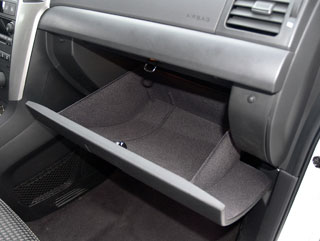

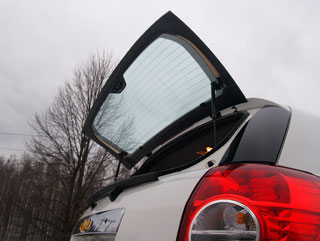
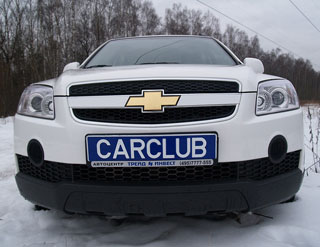
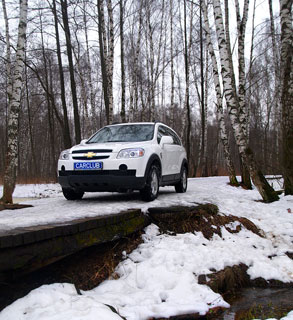
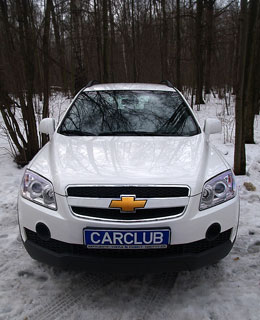
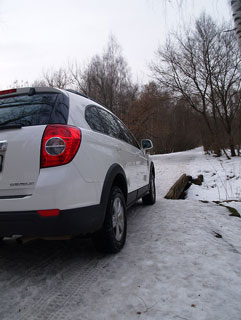
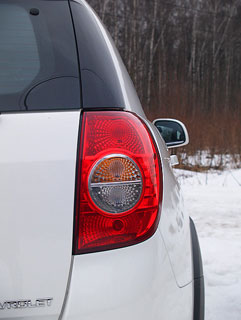
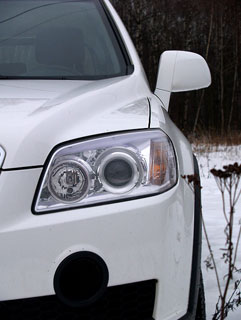
Source: Carclub.ru
Video test drives Chevrolet Captiva since 2006
Chevrolet Captiva Crash Video since 2006
CHEVROLET CAPTIVA test drives since 2006
Chevrolet Captiva Crash Test since 2006
Krassh Test: Detailed Information31%
Driver and passengers
17%
Pedestrians
36%
Children-passengers

